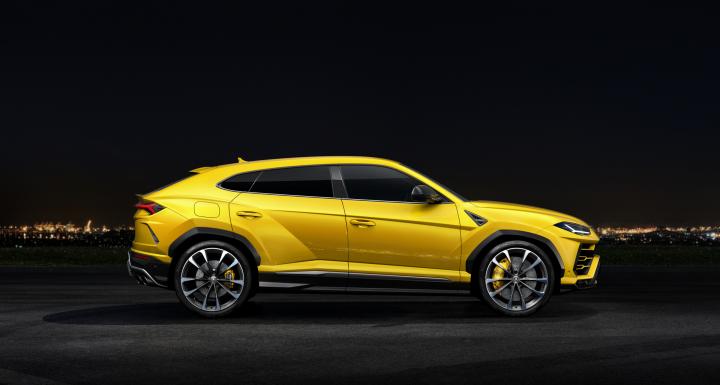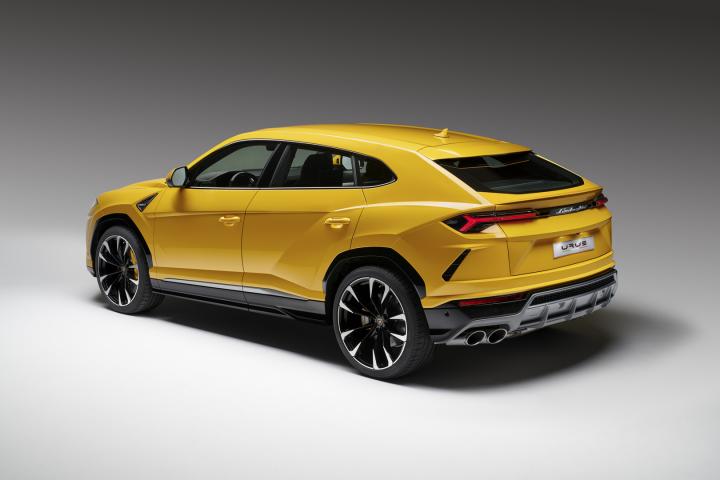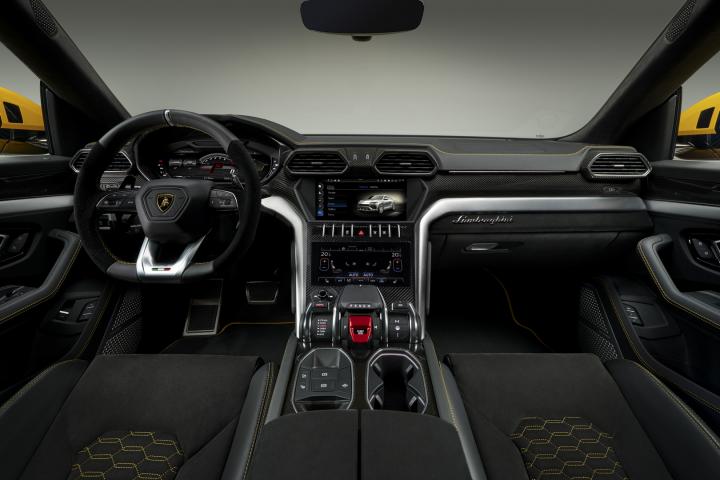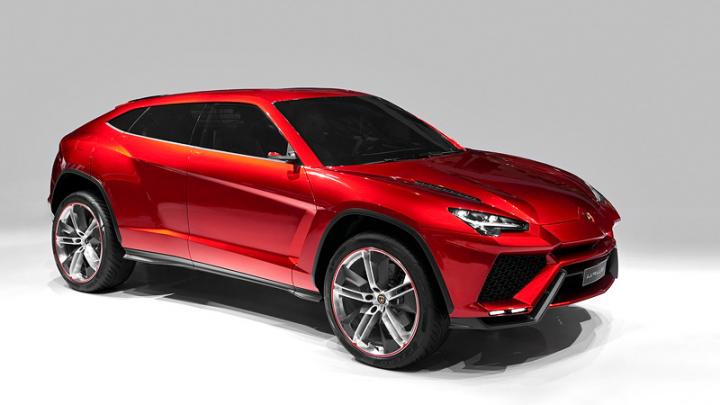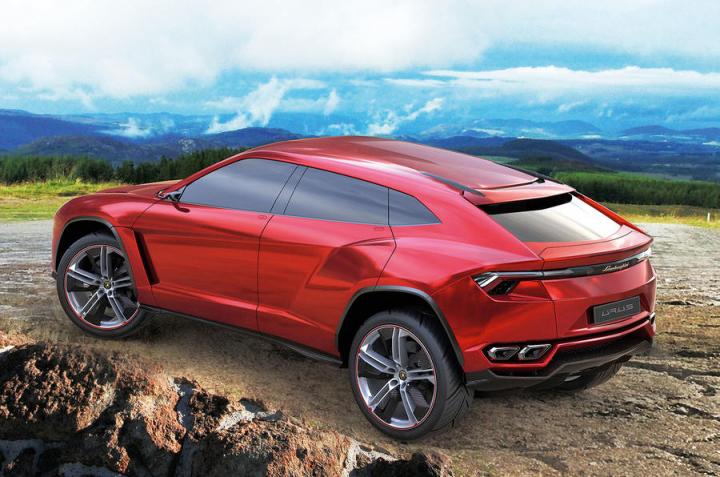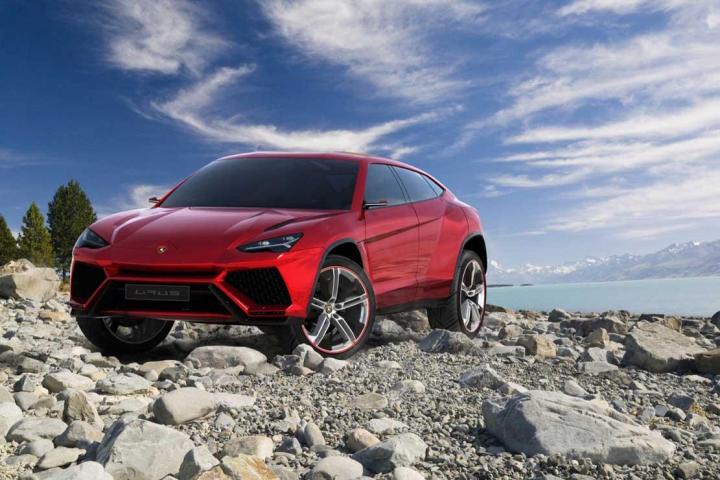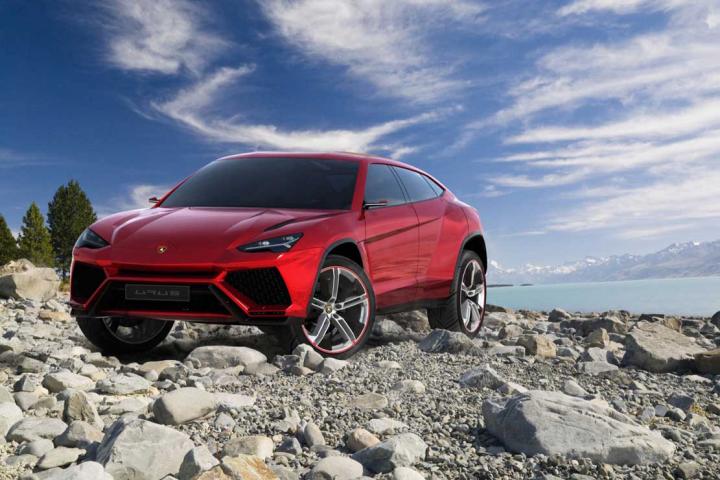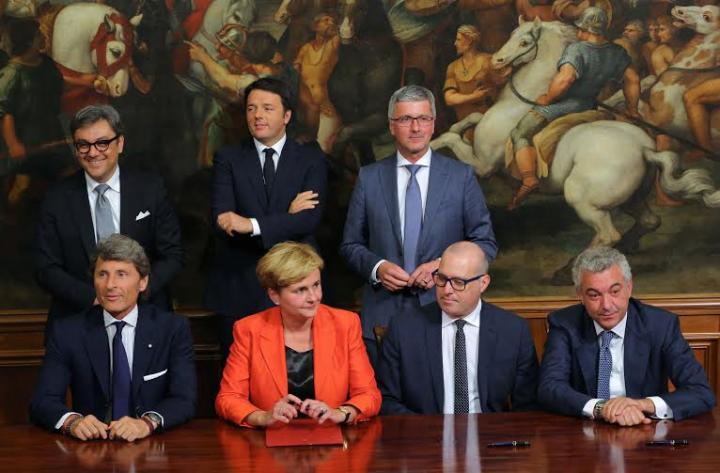News
Lamborghini Urus launched in India priced at Rs. 3 crore
The Lamborghini Urus, which made its global debut in December 2017, has now been launched in India. The SUV is priced at Rs. 3 crore (ex-showroom, India).
After the LM002, the Urus is Lamborghini's second attempt at building a high-performance SUV. It is based on the Volkswagen Group's MLB Evo platform, shared with the Bentley Bentayga, Porsche Cayenne and the Audi Q7. The Urus measures 5,112 mm in length, 2,016 mm in width and 1,638 mm in height. It has a wheelbase of 3,003 mm and comes with an 85-litre fuel tank.
The design of the Urus draws inspiration from the 1980's LM002. The exterior styling is more in tune with the recent design trends at Lamborghini. The front features an inverted U-shaped grille with large air dams on either side while the LED headlights feature Y-shaped DRLs. The Urus has a coupe-like side profile with bold feature lines. The rear features a roof spoiler, raked windshield and Y-shaped LED tail lights in addition to quad-exhaust tips.
Inside, the Urus is offered in 4 or 5 seat configurations. It comes with a three-spoke, multi-functional steering wheel and a TFT instrument cluster. The centre console houses two touchscreen panels - one for the infotainment system while the other provides an interface for the automatic climate control and seat ventilation and heating. Lamborghini's ANIMA drive mode selector has been placed between the front seats.
The Lamborghini Urus is powered by a 4.0-litre, twin-turbo V8 petrol engine that produces 641 BHP @ 6,000 rpm and 850 Nm of torque @ 2,250-4,500 rpm. Power is sent to all four wheels via an 8-speed automatic gearbox. It also has four-wheel steering with dynamic torque vectoring. ANIMA offers 7 driving modes - Strada, Corsa, Sport, Neve (snow), Terra (off-road), Sabbia (sand) and a user customizable EGO mode.
Despite its 2,200 kg kerb weight, Lamborghini claims that it will do 0-100 km/h in 3.6 seconds and has a top speed of 305 km/h. The SUV rides on 21-inch alloy wheels wrapped in 285/45 ZR21 and 315/40 ZR21 tyres in the front and rear respectively. It comes with ceramic brakes measuring 440 mm in the front and 370 mm in the rear.
News
Lamborghini Urus to be launched on January 11, 2018
Recently, Lamborghini unveiled the Urus SUV – it’s first off-road SUV since the LM002. The Italian supercar maker has now announced that the Urus will be launched in India on January 11, 2018.
The Urus is based on the same platform as the Audi Q7, Porsche Cayenne and the Bentley Bentayga. It uses carbon fibre reinforced polymer in its construction. Its styling is inspired by Lamborghinis from the past including the Countach and the LM002. The SUV gets a large inverted U shaped front grille with hexagonal black inserts and an air dam with 4 slats. The rear gets arrow-shaped LED tail lights wrapped around the tail gate.
Inside, the Urus gets a three-spoke steering wheel and a digital cockpit. The centre console houses two touchscreen interfaces and a drive mode selector which is named as the Adaptive Network Intelligent Management (ANIMA). Unlike their other sports cars, the Urus has a proper rear seat and a large boot.
Under the bonnet, the Lamborghini Urus uses a 4.0-litre, twin-turbo V8 instead of a V10 or a V12. The engine produces 641 BHP @ 6,000 rpm and a peak torque of 850 Nm @ 2,250-4,500 rpm. The engine is mated to an all-wheel drive system and a limited-slip central differential. Lamborghini claims that the Urus can accelerate from 0-100 km/h in 3.6 seconds and has a top speed of 305 km/h.
News
2018 Lamborghini Urus SUV unveiled
Lamborghini has revealed its third model line, the Urus. The SUV will go on sale in spring, with prices starting from an estimated US$ 2,00,000.
The exterior design of the Urus is inspired by the LM002, which was an off-road SUV built by Lamborghini from 1986 to 1993. The SUV gets a large inverted U shaped front grille with hexagonal black inserts and an air dam with 4 slats. The bonnet rises up in the center and features a prominent crease. The LED headlights get Y-shaped day time running lights. At the sides, crease lines run from the front to the back and taper upwards.
The rear of the SUV can be described as a coupe / sportback styled, and it gets a spoiler at the top of the rear hatch as well as a prominent lip in the middle. The rear end features quad exhaust pipes with a couple on each side. A reflective strip is located on top of each pair of exhausts. The tail lamps also feature a Y-shaped light element. It also gets two vents at the sides and a couple creases parallel to those on the hatch. The Urus measures 5,112 mm in length, 2,016 mm in width and has a height of 1,638 mm. Wheelbase of the SUV is 3,003 mm. It gets an 85-litre fuel tank and the boot volume is 616 litres and 574 litres for 4 and 5 seat configurations respectively.
The hexagonal theme continues on the inside with the AC vents, door handles, and smaller things like cup holders. It gets a three-spoke multi-function steering wheel and a customizable TFT display. The front seats are heated and get electric 12-way adjustments. An optional 18-way adjustable seats with heating, ventilating and massage options are available as well. The rear seats can be moved and are foldable. They get ISOFIX child seat mounts. The Urus can be configured with a two-seat rear layout as well. The car gets a single colour leather upholstery configurable to multi-colour option with a choice of five shades. Customers can choose Alcantara interiors as well.
The SUV gets four-wheel steering with dynamic torque vectoring, 360-degree monitoring systems, advanced driver assistant systems with Highway and City modes. The four-wheel steering rotates the rear wheels in opposite direction of the front wheels at low speeds and in the same direction at high speeds. An electromechanical active roll stabilization system is introduced for the first time in a Lamborghini model. It is used to minimize the body roll on cornering as well as bumpy roads. It also gets user selectable drive modes like Strada, Corsa, Sport, Neve (snow), Terra (off-road), Sabbia (sand) and a user customizable EGO mode through a Tamburo selector located in the center console.
The Urus is powered by a 4.0-litre, bi-turbo V8 petrol engine that makes 641 BHP @ 6,000 rpm and 850 Nm torque @ 2,250 - 4,500 rpm. Power is sent to all the wheels via an 8-speed gearbox and a limited slip differential. Lamborghini also adds that the car will have a 40:60 front:rear bias by default. With a kerb weight of 2,200 kg, the claimed top speed of the SUV is 305 km/h and a 0-100 km/h time of 3.6 seconds.
The SUV rides on 21-inch alloy wheels with a staggered set of tyres with the front being 285/45 ZR21 and the rear 315/40 ZR21. Braking duties are handled by 10-piston, 440 mm ceramic disks at the front and 6-piston, 370 mm ceramic disks at the rear. The company claims a 100-0 km/h stopping distance of 33.7 m.
- Tags:
- Indian
- Lamborghini
- Urus
- SUV
- International
News
Lamborghini Urus: New details surface ahead of global unveil
The Lamborghini Urus will be powered by a newly developed twin-turbo V8 engine that will churn out around 641 BHP. This information has been revealed by the company's CEO - Stefano Domenicali.
It has also been revealed that Lamborghini is working on a plug-in hybrid version of the aforementioned engine, which will likely be launched a year after the standard model's debut. Lamborghini will likely be unveiling the Urus globally by the end of this year, with deliveries starting in select markets from the second quarter of 2018.
The SUV will be manufactured at the company’s factory in Sant'Agata Bolognese, Italy. This manufacturing facility also develops the Huracan and the Aventador sports car. Interestingly, Lamborghini will be building a new paint shop for the Urus, which will be the first of its kind facility in the said factory. The supercar maker has till now been relying on external suppliers for painting the body shells of its cars.
The Italian automaker is targeting to produce 1,000 units of the Urus SUV in 2018, which will be increased to 3,500 units the following year. However, the company is open to increasing its production capacity if it receives higher demand.
Source: Auto News Europe
News
Lamborghini Urus SUV spied testing in pre-production guise
Lamborghini has finally started testing the Urus SUV, which has recently been photographed in Denmark. While the heavily camouflaged test mule successfully disguised the SUV's key design elements, the overall silhouette and design language of the spotted model appears to be similar to that of the Urus concept unveiled in April, 2012.
The spy shots point towards a coupe-style SUV, which is characterized by a sloping roof line and a short rear overhang. The tail light clusters appear to be makeshift units, though the indent made for the final cluster is similar to the one found on the concept. However, the test mule comes with just two exhaust tips placed on the left side, instead of the concept's quad exhausts.
Lamborghini had earlier confirmed that the SUV will be retaining the Urus name plate and will enter pre-series production in April. It will share its underpinnings with the Audi Q7. Powering the Urus will be a 4.0-litre biturbo V8 petrol engine, while a diesel mill has been ruled out by the automaker. Instead the company is reportedly working on pure-electric and plug-in hybrid powertrains for the SUV.
Source: Pro-Street Denmark
- Tags:
- Indian
- Urus
- International
News
Lamborghini Urus SUV - More details revealed
Lamborghini is expected to unveil the Urus SUV next year, which will likely go on sale in the international markets by 2018. The company's R&D chief, Maurizio Reggiani, has now revealed a few more details about the upcoming SUV.
The biggest confirmation about the Urus SUV revolves around its powertrain options. It will be the first Lamborghini model to be available with a plug-in hybrid setup. Reggiani has also confirmed that it will be the only plug-in hybrid model coming from the Italian supercar maker. The other offered powertrain option will be a twin-turbo 4.0-litre V8 engine. The R&D chief claimed that turbocharging is 'completely mandatory' for the Urus, as SUVs require huge torque.
The Urus will be based on the same platform that underpins the Audi Q7 and the Bentley Bentayga. It will thus borrow various chassis components from these two SUVs, including the 48V powered active anti-roll suspension system. Lamborghini will be offering the Urus in both all-wheel-drive and rear-wheel-drive variants.
Source: Autocar
- Tags:
- Indian
- Urus
- International
News
Lamborghini: Turbo-charged engines coming up
Lamborghini known for its naturally aspirated V10 and V12 engines now plans on introducing a turbocharged unit to its upcoming Urus SUV, which is likely to make its debut in 2018.
In an interview with with AutoExpress, Stephan Winkelmann, Lamborghini's CEO revealed that for the first time, they will resort to a turbocharged mill to power this SUV. This motor is likely to be a 4.0 litre twin-turbo V8 motor seen on the Audi RS6 and RS7, in which this motor produces over 550 BHP and 700 Nm of torque, mated to an 8-speed transmission. The power and torque figures are likely to be bumped up on the Lamborghini SUV.
It seems like the ever-tightening emission norms are getting the better of car manufacturers, who are now resorting to forced induction for their vehicles. While the supercars in the Lamborghini line-up still use a naturally aspirated engines, it is only a matter of time, when these too will be replaced with turbo-powered motors.
- Tags:
- Indian
- Urus
- International
- Turbocharger
News
Confirmed: Lamborghini Urus debut in 2018
Italian supercar maker Lamborghini has officially confirmed, that the brand’s first SUV since the LM002 will arrive in 2018. Seen first as the Urus concept (production model likely to use a different name), the SUV will be the third product offered as a part of Lamborghini’s global range.
The new SUV will be produced at the brand’s plant in Sant’Agata Bolognese and will warrant an expansion in the plant’s production capacity. The factory size will expand from the current 80,000 square metres to 1,50,000 square metres. The project will include the construction of new facilities, including a new production line, warehousing and enlargement of the R&D department. Lamborghini also intends to expand its workforce by around 500 employees.
Lamborghini has not stated an exact amount that will be invested for the development of the new product or the expansion of the plant. However, the official release states that the company will pump in “hundreds of millions of Euros”. Annual volumes for the SUV will be around 3,000 units, with target markets primarily consisting of the USA, China, UK, Germany, Russia and the Middle-East.
- Tags:
- Indian
- International
- Urus
Pages
- « first
- ‹ previous
- 1
- 2
- 3



.jpg)

